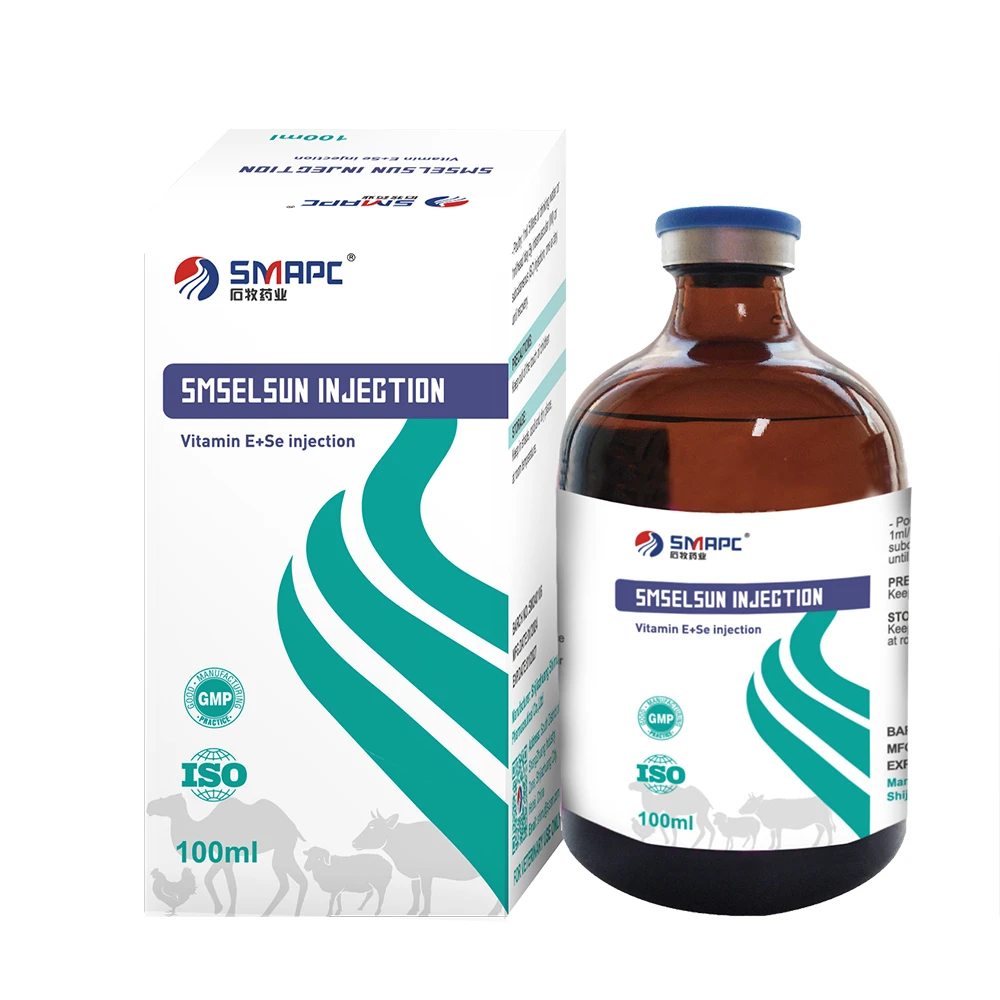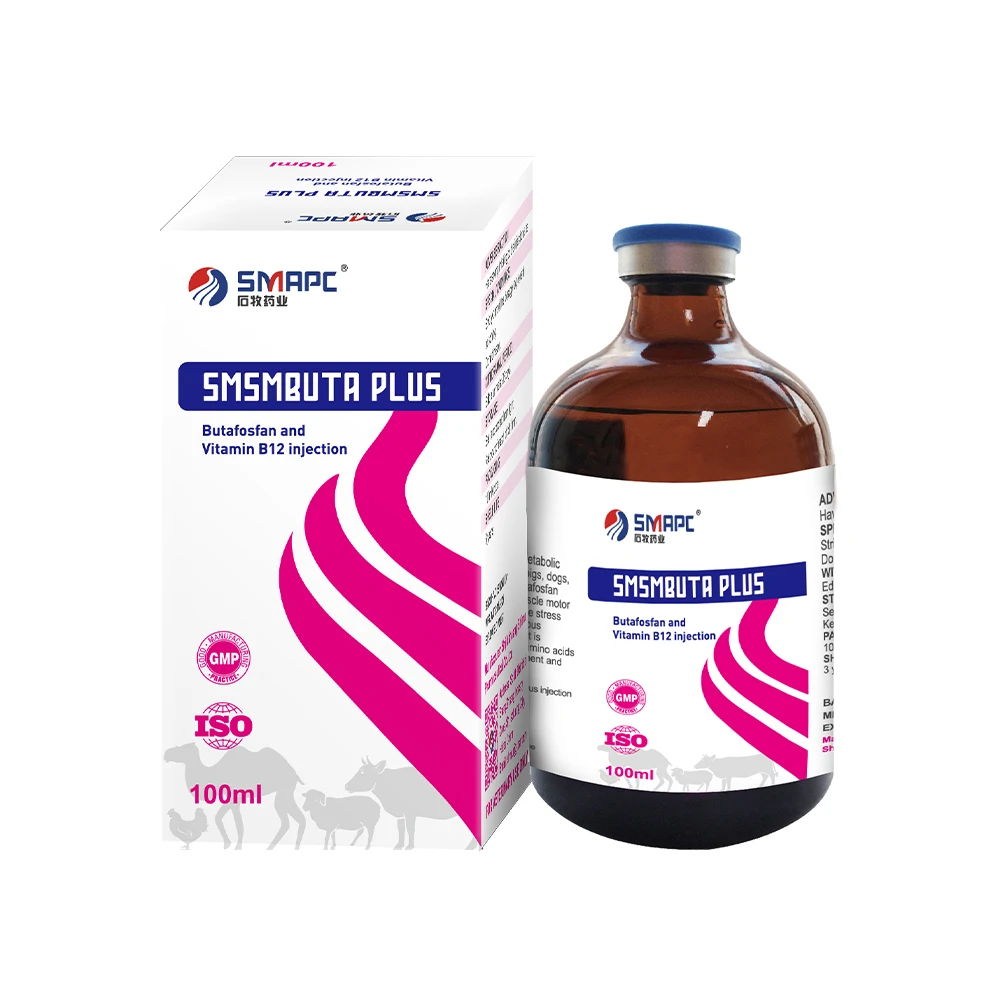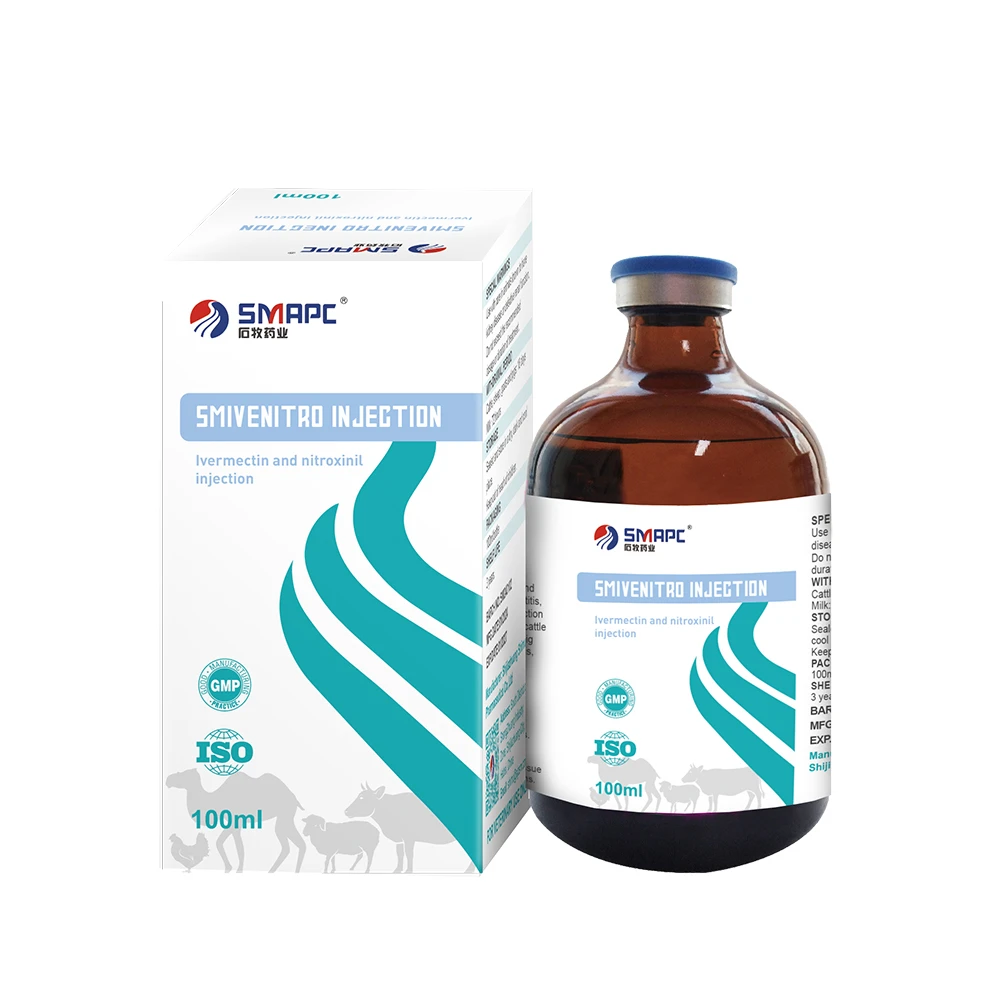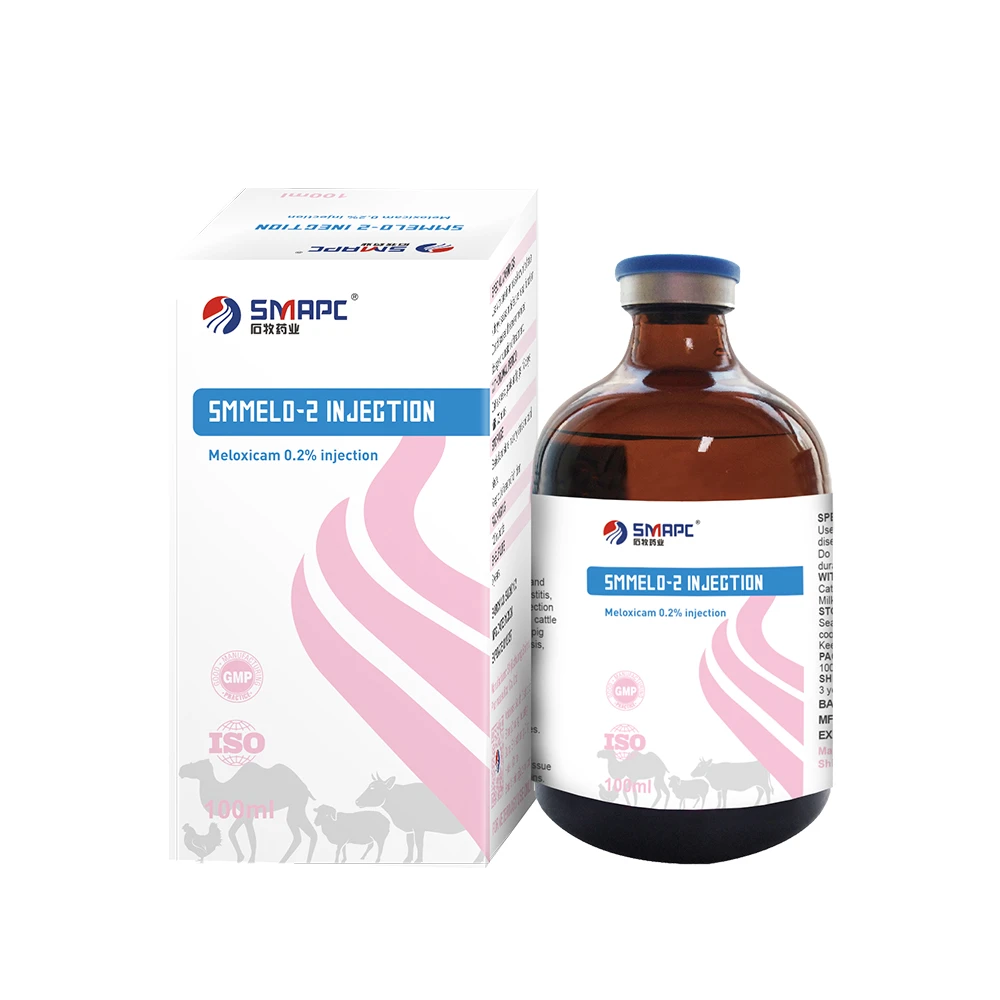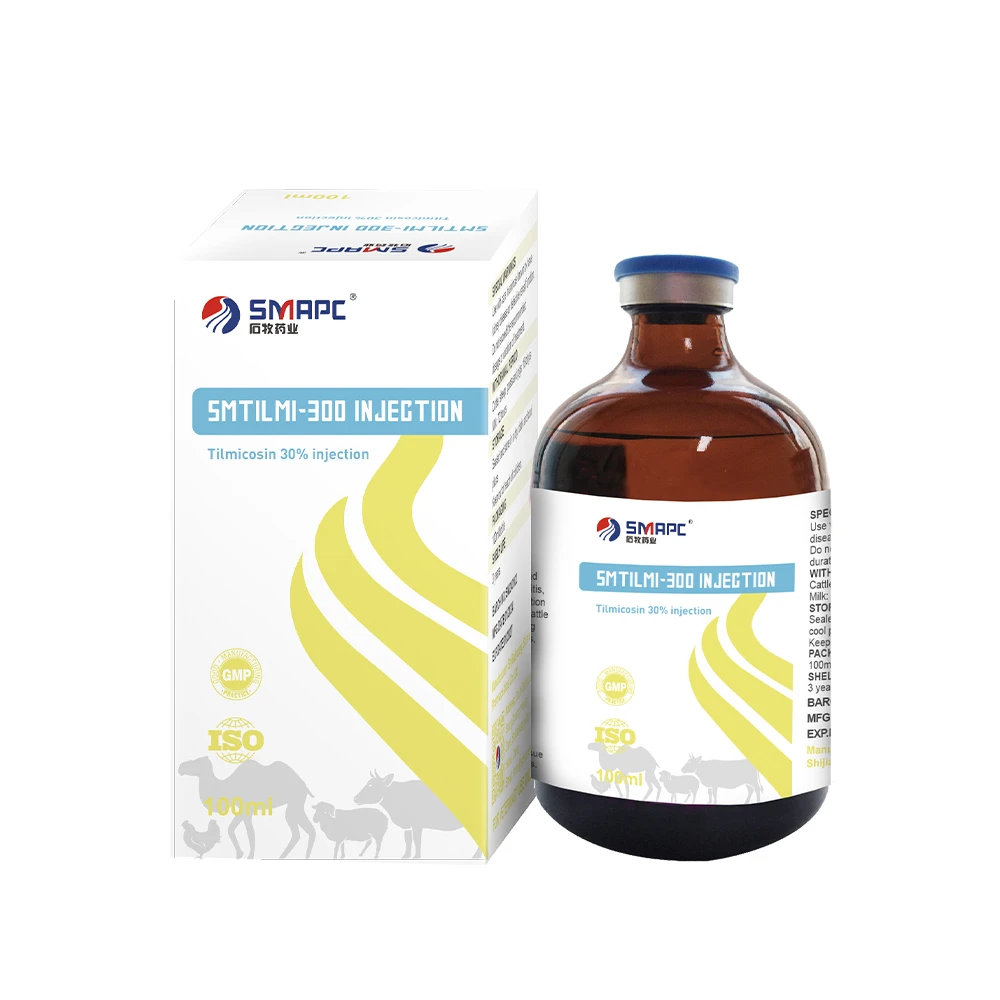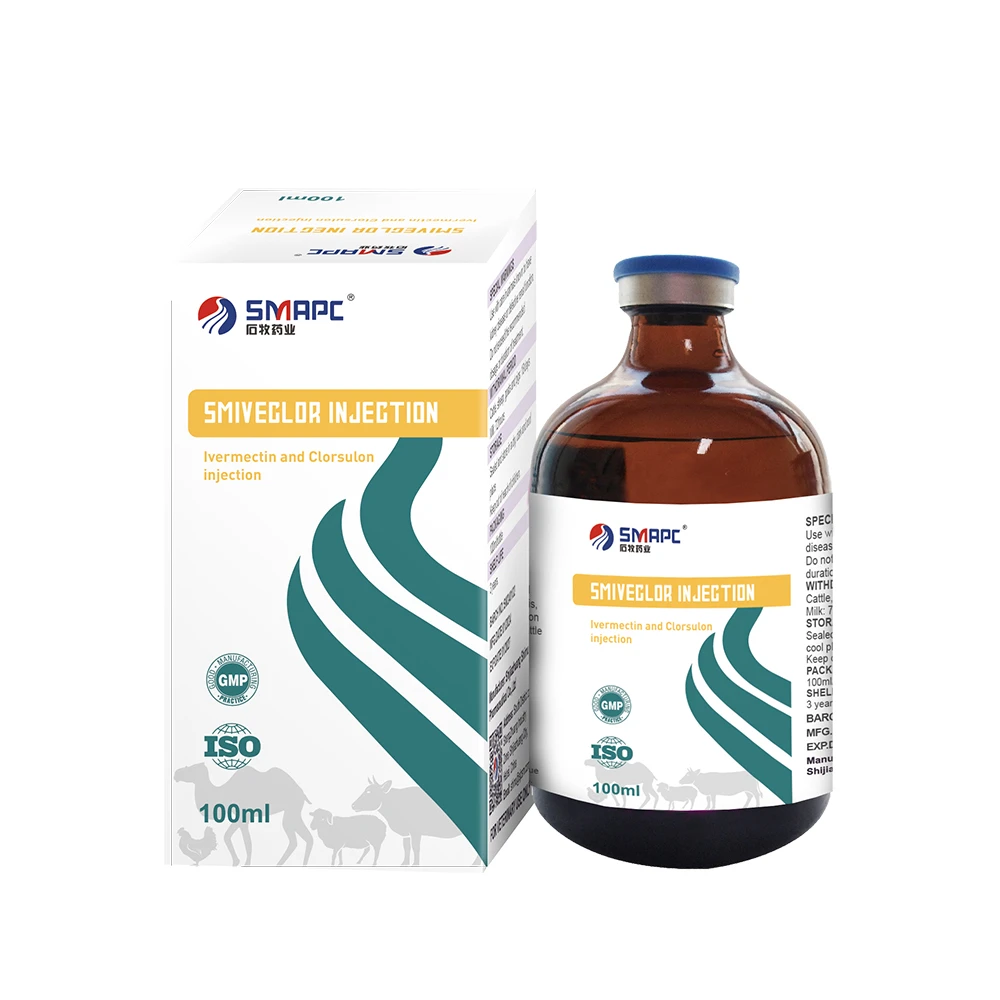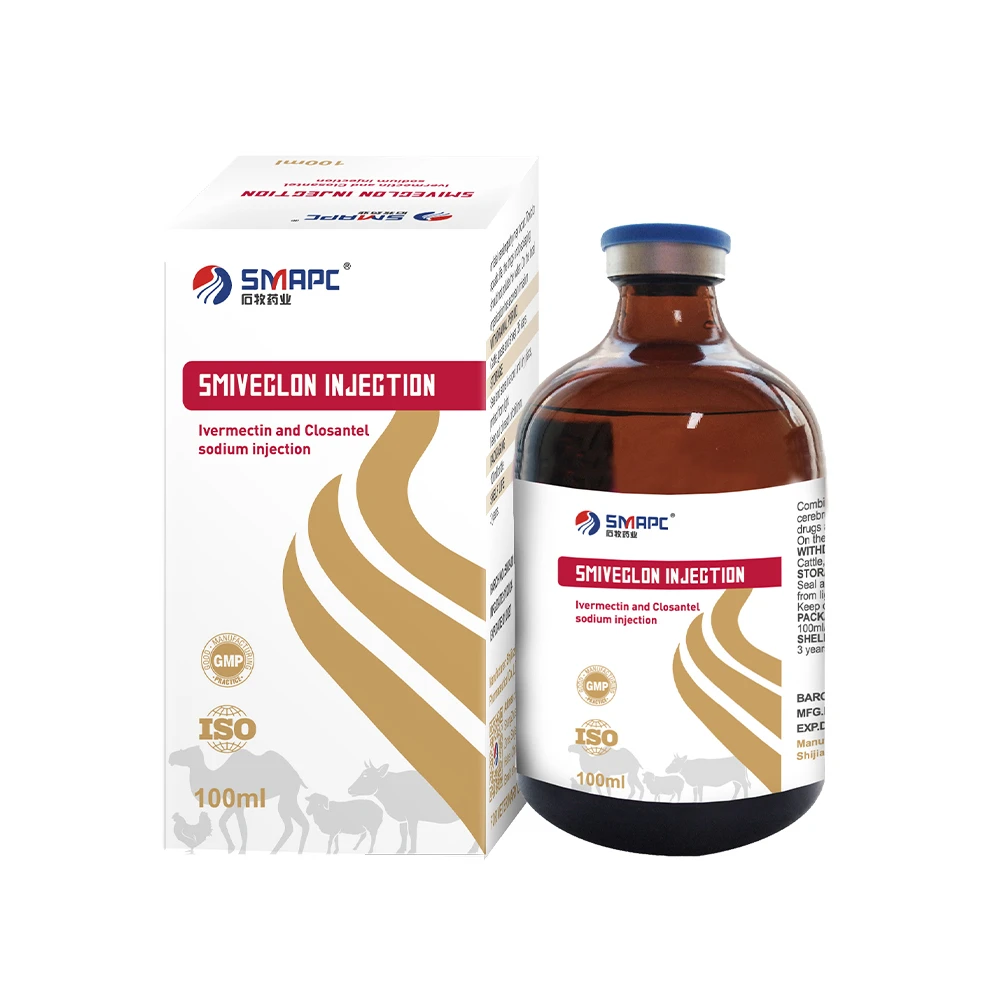Aug . 21, 2025 21:00 Back to list
Essential Veterinary Injection List for Animal Health & Care
The Evolving Landscape of Veterinary Injection List: Trends, Challenges, and Opportunities
The global animal health industry is experiencing rapid transformation, driven by increasing demand for animal protein, the rising pet ownership, and a heightened focus on animal welfare and food safety. Central to this evolution is the critical role of the veterinary injection list, encompassing a vast array of therapeutic and prophylactic solutions. From antibiotics and antiparasitics to vaccines and nutritional supplements, these injectable formulations are indispensable for effective disease management and animal productivity. The market for veterinary pharmaceuticals, valued at approximately $45 billion in 2023, is projected to reach over $70 billion by 2030, demonstrating a Compound Annual Growth Rate (CAGR) of around 6.5%. This growth is largely underpinned by advancements in drug discovery, stringent regulatory frameworks ensuring product safety and efficacy, and a growing understanding of animal health economics.
Current industry trends emphasize precision veterinary medicine, aiming for targeted treatments that minimize drug resistance and environmental impact. This involves sophisticated diagnostic tools that inform treatment decisions, leading to a more rational use of the veterinary injection list. Furthermore, there's a strong drive towards novel drug delivery systems, extended-release formulations, and combination therapies to improve compliance, reduce stress on animals, and enhance therapeutic outcomes. The challenges include navigating complex regulatory landscapes, combating antimicrobial resistance, and ensuring equitable access to essential veterinary medicines across diverse economic regions. For B2B stakeholders, understanding these dynamics is crucial for strategic sourcing, product development, and market penetration, ensuring their veterinary injection list offerings meet the highest standards of quality and efficacy.
In this context, specialized products like Nitroxinil Injection stand out, representing the cutting edge in antiparasitic solutions. Its consistent efficacy and adherence to international quality benchmarks make it a vital component in modern animal health management, addressing specific parasitic challenges that impact livestock productivity and welfare globally.
Decoding the Manufacturing Excellence of the Veterinary Injection List
The production of a high-quality veterinary injection list demands meticulous attention to detail, adherence to stringent regulatory standards, and the application of advanced pharmaceutical manufacturing techniques. Unlike oral medications, injectables require absolute sterility, precise dosing, and excellent stability to ensure safety and efficacy. Manufacturers like Skyvetpharm prioritize Good Manufacturing Practices (GMP) and ISO certifications to guarantee the integrity of every batch.
Detailed Process Flow for Veterinary Injections:
1. Raw Material Sourcing & Qualification:
The foundation of any superior veterinary injection begins with the sourcing of high-purity Active Pharmaceutical Ingredients (APIs) and pharmaceutical-grade excipients. This involves rigorous supplier qualification, auditing, and testing of each incoming raw material against pharmacopoeial standards (e.g., USP, BP, EP) and internal specifications. For APIs like Nitroxinil, purity assays, impurity profiles, and stability data are meticulously analyzed to ensure chemical integrity and suitability for injection. Excipients, including solvents, pH adjusters, preservatives, and solubilizers, are selected based on their compatibility, safety profile, and contribution to formulation stability and bioavailability.
2. Formulation Development & Stability Testing:
Before large-scale production, extensive R&D is conducted to develop the optimal formulation. This phase involves defining the precise concentration of API, selecting appropriate excipients to achieve desired solubility, pH, tonicity, and stability, and ensuring the formulation is suitable for injection. Accelerated and real-time stability studies are critical to determine the product's shelf-life under various environmental conditions, assessing parameters such as potency, clarity, particulate matter, and degradation products. This ensures that the product retains its therapeutic efficacy throughout its declared shelf life.
3. Compounding & Mixing:
This stage involves the precise weighing and mixing of the API and excipients in a controlled environment. Aseptic techniques are paramount to prevent microbial contamination. Specialized mixing equipment ensures homogeneity of the solution or suspension. Water for Injection (WFI), which meets stringent purity standards, is typically used as the primary solvent. All operations are conducted in classified cleanrooms (e.g., ISO Class 7 or 8) to minimize particulate and microbial load.
4. Sterile Filtration:
For sterile liquid injectables, the compounded solution undergoes sterile filtration using membrane filters with a pore size typically 0.22 microns. This process physically removes bacteria, fungi, and other particulate matter, ensuring the solution is rendered sterile. Filter integrity tests are performed before and after filtration to confirm the filter's effectiveness. This is a critical step for products on the veterinary injection list designed for intravenous or intramuscular administration.
5. Aseptic Filling & Sealing:
The sterile solution is then filled into pre-sterilized vials or ampoules within an ISO Class 5 (Class 100) cleanroom environment, using highly automated filling lines. This ultra-clean environment, often achieved through HEPA-filtered laminar airflow, prevents any contamination during the filling process. After filling, vials are immediately stoppered with sterile rubber stoppers (typically bromobutyl rubber due to its low permeability) and sealed with aluminum crimps. This creates a hermetic seal, protecting the product from external contaminants and maintaining sterility.
6. Inspection & Packaging:
Post-filling, each vial undergoes rigorous visual inspection, either manually or using automated inspection machines, to detect any particulate matter, cracks in the glass, or faulty seals. Only perfectly inspected products proceed to labeling and packaging. This involves applying accurate labels with product name, concentration, batch number, expiration date, and storage instructions. Products are then packed into secondary packaging (boxes) along with package inserts, ready for distribution.
7. Quality Control (QC) & Quality Assurance (QA):
Throughout the entire manufacturing process, from raw material to finished product, comprehensive QC tests are performed. These include:
- Sterility Testing: Ensuring no microbial growth.
- Potency Testing: Verifying the API concentration.
- Endotoxin Testing: Detecting bacterial endotoxins, critical for injectables.
- pH Measurement: Ensuring physiological compatibility.
- Particulate Matter Analysis: Quantifying and sizing insoluble particles.
- Identity Testing: Confirming the correct API.
- Stability Studies: Ongoing monitoring of product quality over time.
Key Specifications and Standards:
- Product Material Excellence:
- Vials: Type I borosilicate glass, known for its superior chemical resistance and low extractables, ensuring no interaction with the injectable solution.
- Stoppers: High-grade bromobutyl rubber, providing excellent chemical inertness, gas impermeability, and resealability after needle penetration.
- API Purity: Pharmaceutical grade, adhering to standards like USP (United States Pharmacopeia), BP (British Pharmacopoeia), or EP (European Pharmacopoeia).
- Manufacturing Processes: Predominantly aseptic filling within ISO Class 5 (Grade A) environments to prevent microbial contamination. Validation of sterilization cycles for equipment and components is critical.
- Inspection Standards: Adherence to global pharmaceutical standards such as cGMP (current Good Manufacturing Practices) outlined by agencies like the FDA (U.S. Food and Drug Administration) and EMA (European Medicines Agency). ISO 9001 certification ensures a robust quality management system.
- Service Life & Stability: Products are formulated for a specific shelf-life, typically 2-3 years, when stored under recommended conditions (e.g., controlled room temperature, protection from light). Stability data supports these claims.
- Applicable Industries (Animal Sectors): The diverse veterinary injection list serves a wide range of animal industries, including:
- Livestock Farming: Cattle, sheep, goats, swine (e.g., for anthelmintics, antibiotics, vaccines).
- Poultry Industry: Chickens, turkeys (e.g., for vaccines, certain antibiotics).
- Companion Animals: Dogs, cats, horses (e.g., for vaccines, pain management, antibiotics).
- Aquaculture: Fish (e.g., for specific vaccines or parasiticides).
- Typical Advantages in Application (Beyond Manufacturing):
- High Bioavailability: Injectables often provide higher and more consistent bioavailability compared to oral formulations, leading to more predictable therapeutic effects.
- Rapid Onset of Action: Crucial in acute conditions or when immediate therapeutic levels are required.
- Controlled Release: Certain formulations offer extended therapeutic periods, reducing the frequency of administration and improving compliance.
- Targeted Delivery: Ability to deliver drugs directly into the bloodstream or specific tissues.
- Reduced Waste: Efficient dosing minimizes environmental footprint.
Key Technical Parameters for a Comprehensive Veterinary Injection List
Understanding the technical parameters of various injectable veterinary medicines is paramount for effective disease management and optimal animal health outcomes. These parameters define a product's efficacy, safety, and application profile. Below is a representative table illustrating common technical parameters relevant to the broad veterinary injection list, alongside specific considerations for antiparasitic agents, including our flagship Nitroxinil Injection.
| Parameter | Description/Relevance | Typical Range/Value | Impact on Application |
|---|---|---|---|
| Active Pharmaceutical Ingredient (API) | The primary compound responsible for the therapeutic effect. Purity and stability are critical. | e.g., Nitroxinil, Ivermectin, Oxytetracycline | Determines the drug's mechanism of action and specific indications. |
| Concentration | Amount of API per unit volume (e.g., mg/ml, % w/v). Directly impacts dosing. | e.g., 25% w/v (Nitroxinil), 1% (Ivermectin) | Influences injection volume, ease of administration, and cost per dose. |
| Volume per Vial/Bottle | Standard packaging sizes for commercial and field use. | e.g., 50ml, 100ml, 250ml, 500ml | Affects practicality for different farm sizes and economic considerations. |
| Route of Administration | How the product is administered (IM, SC, IV). Impacts absorption and onset. | Intramuscular (IM), Subcutaneous (SC), Intravenous (IV) | Determines suitability for specific animal species, conditions, and user expertise. |
| pH Range | The acidity or alkalinity of the solution. Critical for stability, solubility, and injection site comfort. | Typically 6.0 - 8.0 for many injectables; specific to API. | Ensures product stability and minimizes irritation or tissue damage at injection site. |
| Osmolality/Tonicity | Measure of solute concentration. Isotonic solutions minimize cellular damage. | Isotonic (approx. 280-310 mOsm/kg for mammals) | Reduces pain and tissue damage upon injection, especially for large volumes. |
| Pharmacokinetics (PK) Profile | Absorption, Distribution, Metabolism, Excretion (ADME) characteristics. | Onset of action (e.g., rapid, | Determines dosing frequency, withdrawal periods, and overall efficacy. |
| Withdrawal Period | Time required between the last drug administration and when animal products (meat, milk, eggs) can be safely consumed. | e.g., Meat: 28 days, Milk: 7 days (varies by drug/species) | Crucial for food safety and regulatory compliance in food-producing animals. |
| Storage Conditions | Recommended temperature, light exposure, and humidity for maintaining product stability. | Room temperature (15-30°C), Refrigerated (2-8°C), Protect from light. | Ensures product integrity throughout its shelf life, impacts logistics. |
| Shelf Life | The period during which the product remains stable and potent. | Typically 24-36 months from manufacturing date. | Influences inventory management and expiration risk for end-users. |
Nitroxinil Injection: Exemplifying the Veterinary Medicine Veterinary Injection List
Nitroxinil Injection is a prime example of a specialized product within the broader veterinary medicine veterinary injection list, specifically designed for the effective treatment of fascioliasis (liver fluke infestations) and certain gastrointestinal nematodes in livestock. Its unique chemical structure and pharmacological profile make it a preferred choice for challenging parasitic infections.
Key Specifications of Nitroxinil Injection (e.g., 25% w/v):
- Active Ingredient: Nitroxinil
- Concentration: Typically 25% w/v (250 mg/ml). This high concentration allows for lower injection volumes.
- Target Parasites: Highly effective against mature and immature Fasciola hepatica (liver fluke), Fasciola gigantica, Haemonchus contortus (barber pole worm), Bunostomum, and Oesophagostomum.
- Route of Administration: Subcutaneous (SC) injection is generally preferred, ensuring good absorption and distribution.
- Mechanism of Action: Nitroxinil acts as an uncoupler of oxidative phosphorylation in the helminth's mitochondria, disrupting ATP production and leading to parasite death. This unique mechanism helps in combating resistance seen with other anthelmintics.
- Pharmacokinetics: After subcutaneous administration, Nitroxinil is absorbed, reaching peak plasma concentrations within 24-48 hours. It binds extensively to plasma proteins, leading to a sustained presence in the bloodstream and bile, which is crucial for its efficacy against liver flukes. Its half-life can range from 3-8 days depending on species.
- Dosage: Varies by species and target parasite (e.g., 10 mg/kg body weight for Fascioliasis in cattle). Precise dosage calculation is vital for efficacy and safety.
- Withdrawal Period: Typically 28-30 days for meat in cattle and sheep; milk withdrawal periods are also specified and must be strictly observed.
- Storage: Store below 25°C, protected from light. Do not freeze.
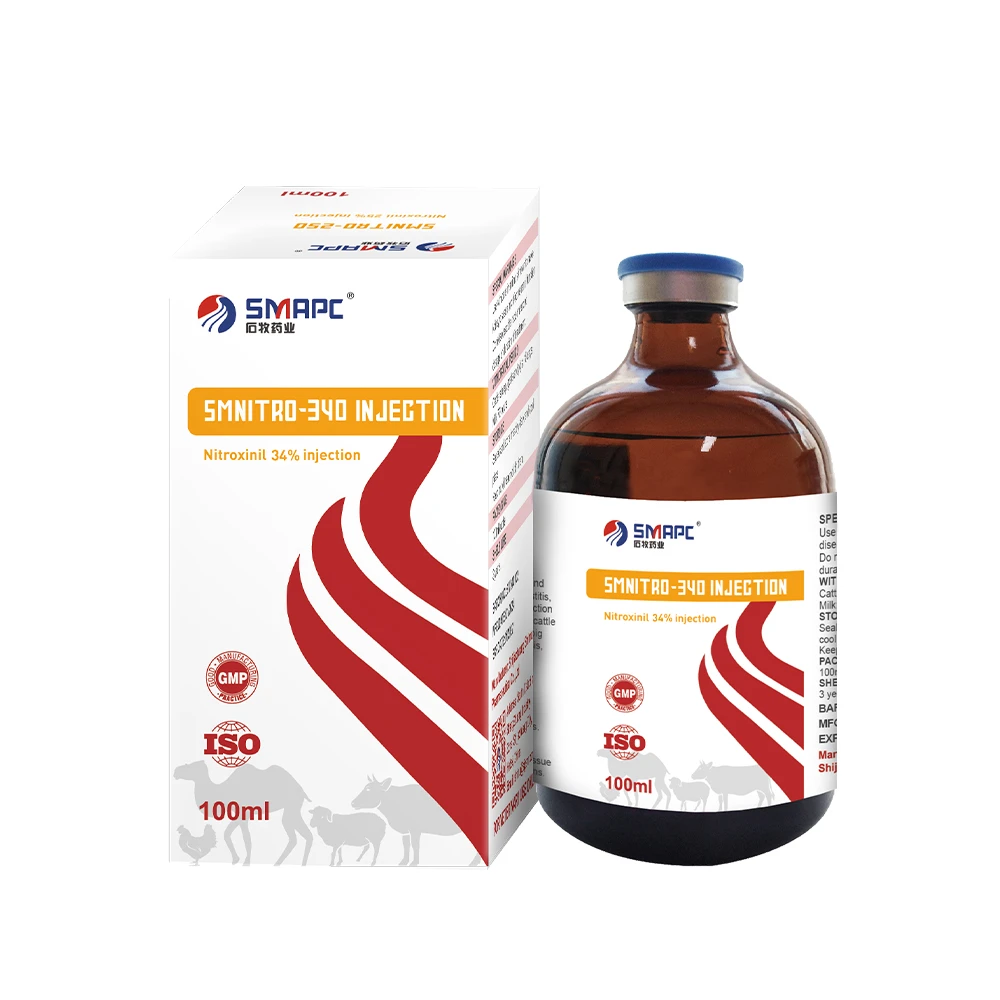
Image: High-quality injectable solutions, a key component of a robust veterinary injection list.
Strategic Advantages: From Technical Superiority to Custom Solutions for Your Veterinary Antibiotic Injection List
For B2B buyers and distributors, selecting a reliable partner for their veterinary antibiotic injection list and other critical injectables goes beyond just product availability. It involves evaluating technical superiority, manufacturing capabilities, and the flexibility for custom solutions. Skyvetpharm embodies these advantages, ensuring partners receive products that deliver consistent performance and comply with global standards.
Technical Advantages of Partnering with Skyvetpharm:
- Robust R&D Capabilities: Our continuous investment in research and development allows us to anticipate market needs and develop innovative formulations. This includes exploring new APIs, optimizing existing formulations for enhanced stability and bioavailability, and developing solutions for emerging disease challenges in the realm of the veterinary antibiotic injection list and beyond.
- Uncompromising Quality Assurance: Adherence to international quality standards such as cGMP (current Good Manufacturing Practices), ISO 9001:2015, and compliance with national regulatory bodies (e.g., FDA equivalents in target markets) is non-negotiable. Every batch undergoes rigorous testing, ensuring purity, potency, sterility, and stability. Our Quality Management System (QMS) is regularly audited to maintain peak operational standards.
- Advanced Manufacturing Infrastructure: Our facilities are equipped with state-of-the-art aseptic filling lines, controlled cleanroom environments, and automated inspection systems, minimizing human error and maximizing product integrity. This ensures the consistent quality of every product on our veterinary injection list.
- Expertise in Pharmacokinetics and Formulation Science: Our team of veterinary scientists and pharmaceutical formulators possesses deep expertise in tailoring drug delivery systems for optimal therapeutic outcomes in various animal species, addressing specific absorption, distribution, metabolism, and excretion profiles.
- Reliable Supply Chain Management: We maintain a robust and resilient supply chain, ensuring consistent availability of raw materials and timely delivery of finished products globally. This minimizes disruptions for our partners, crucial for planned veterinary interventions.
Manufacturer Comparison: Why Choose Skyvetpharm for Your Veterinary Injection List
When evaluating suppliers for your veterinary injection list, key differentiators emerge beyond just product cost. Here's a comparative overview:
| Criterion | Skyvetpharm | Typical Generic Manufacturer | Large Global Pharma (Animal Health Division) |
|---|---|---|---|
| Quality Certifications | GMP, ISO 9001:2015, Consistent regulatory compliance across regions. | May meet local GMP, but international certifications might be limited or less comprehensive. | Extensive global certifications (FDA, EMA, etc.), high R&D. |
| R&D Investment & Innovation | Significant ongoing investment in new formulations, efficacy trials, and resistance management. | Minimal R&D; primarily focuses on bioequivalence of off-patent drugs. | Very high R&D, often pioneering novel molecules and technologies. |
| Product Range & Specialization | Focused range of high-efficacy products (e.g., Nitroxinil), with expertise in specific therapeutic areas. Comprehensive veterinary injection list. | Broad but often undifferentiated range of standard generics. | Extremely broad, covering almost all animal health categories. |
| Customization & Flexibility | High flexibility for private labeling, specific volume requests, packaging, and formulation tweaks for B2B partners. | Limited customization, focus on mass production of standard products. | Very low, typically only for extremely large strategic partnerships. |
| Technical Support & After-Sales | Dedicated veterinary technical support, comprehensive data sheets, training, and swift issue resolution. | Basic product information, limited technical or veterinary support. | Extensive global technical support, often with local teams and extensive research. |
| Value Proposition | Optimal balance of high quality, proven efficacy, regulatory compliance, competitive pricing, and strong partner support. | Primarily cost-driven, potentially compromising on consistency or support. | Premium pricing for cutting-edge innovation and global brand recognition. |
Tailored Custom Solutions:
Recognizing that different markets and partners have unique requirements, Skyvetpharm offers bespoke solutions to integrate our products seamlessly into your existing operations. This includes:
- Private Labeling (OEM/ODM): We can supply our high-quality veterinary injection list products, including Nitroxinil Injection, under your brand name and packaging, ensuring brand consistency and market recognition for your business.
- Volume Flexibility: Whether you require bulk supply for large-scale distribution or specific batch sizes for niche markets, we can accommodate diverse order volumes.
- Regulatory Support: Our regulatory affairs team can assist partners in navigating the specific import and registration requirements for veterinary pharmaceuticals in their target countries, facilitating market entry and compliance.
- Packaging Customization: From vial sizes and stopper types to carton designs and multi-lingual labeling, we offer flexible packaging options to meet local market preferences and regulatory demands.
- Formulation Adjustments (Feasibility Dependent): For specific large-volume partners, and where scientifically and regulatorily feasible, we can discuss minor formulation adjustments to meet unique market needs, such as excipient preferences or specific concentrations.
Real-World Impact and Application Cases of Our Veterinary Injection List
The true value of a comprehensive veterinary injection list is realized through its tangible impact on animal health and farm productivity. Our products, especially specialized solutions like Nitroxinil Injection, have demonstrated significant efficacy in diverse real-world scenarios, leading to improved animal welfare and economic benefits for livestock producers globally. These application cases underscore our commitment to delivering reliable and effective veterinary medicines.
Application Case 1: Enhanced Liver Fluke Control in Dairy Cattle
Challenge:
A large-scale dairy farm in a region with high prevalence of Fasciola hepatica (liver fluke) was experiencing reduced milk yield, poor fertility rates, and general ill-thrift across its herd. Despite routine deworming with standard flukicides, subclinical fascioliasis remained a persistent issue, leading to significant economic losses due to impaired liver function and chronic disease.
Solution with Nitroxinil Injection:
Working with the farm's veterinary consultant, a strategic treatment program was implemented, incorporating Nitroxinil Injection (25% w/v) at a dose of 10 mg/kg body weight via subcutaneous injection. The program involved treating all susceptible animals twice annually, specifically targeting periods of high fluke challenge (e.g., late autumn and early spring) based on epidemiological data and fecal egg counts. The precise dosing facilitated by the high concentration of Nitroxinil ensured accurate delivery and therapeutic levels.
Results & Impact:
- Improved Milk Yield: Within 3 months of the initial treatment, the farm reported an average increase of 1.5 - 2.0 liters of milk per cow per day, attributing it to improved liver function and nutrient utilization.
- Enhanced Fertility: Conception rates improved by approximately 10-15%, reducing the calving interval and leading to a more efficient breeding cycle.
- Reduced Mortality/Morbidity: Cases of chronic wasting and severe anemia, previously linked to fascioliasis, significantly declined.
- Economic Benefit: The estimated return on investment (ROI) from using Nitroxinil Injection for this farm was calculated to be more than 4:1 within the first year, primarily from increased milk production and reduced veterinary costs. This success highlighted Nitroxinil's effectiveness within the broader veterinary medicine veterinary injection list.
Application Case 2: Controlling Haemonchosis in Small Ruminant Operations
Challenge:
A sheep breeding operation was facing severe challenges from Haemonchus contortus (barber pole worm), a blood-feeding nematode causing acute anemia, weight loss, and high mortality in lambs and ewes, particularly during warm, wet seasons. Resistance to several commonly used anthelmintics was suspected, leading to ineffective treatments and ongoing production losses. This highlighted a critical need for effective solutions from the veterinary antibiotic injection list, specifically for parasites.
Solution with Nitroxinil Injection:
Following diagnostic confirmation of Haemonchus presence and suspected resistance, Nitroxinil Injection was introduced into the farm's parasite control program. Nitroxinil was administered to affected sheep and lambs at the recommended dose for gastrointestinal nematodes (e.g., 7.5 mg/kg body weight, SC). The quick onset of action and efficacy against resistant strains made it an ideal choice for emergency treatment and targeted control.
Results & Impact:
- Rapid Clinical Improvement: Animals treated showed rapid recovery from anemia and improved appetite within days of injection.
- Reduced Parasitic Burden: Fecal egg count reduction tests (FECRT) confirmed high efficacy (over 95% reduction) against Haemonchus contortus, even where other drugs had failed.
- Decreased Mortality: Lamb mortality rates due to haemonchosis dropped significantly, saving valuable young stock.
- Improved Flock Health & Productivity: Overall flock health, weight gains, and lambing rates improved due to effective parasite control. The farm incorporated Nitroxinil as a rotational anthelmintic to manage resistance, demonstrating its strategic importance in the veterinary injection list.
Client Feedback and Experience:
"Our experience with Skyvetpharm's veterinary injection list has been consistently positive. The quality and efficacy of products like Nitroxinil Injection have directly contributed to healthier animals and more profitable operations. Their technical support team is always responsive and knowledgeable, providing valuable insights for our specific challenges. The consistent supply and adherence to international standards make them a truly trusted partner in our animal health strategy." - Leading Animal Health Distributor, EMEA Region
"Switching to Nitroxinil for our toughest fluke cases was a game-changer. We've seen a noticeable reduction in liver condemnations and an improvement in overall herd performance. It's a testament to the quality manufacturing and efficacy that Skyvetpharm brings to the veterinary injection list." - Veterinarian, Large Cattle Practice, South America
Ensuring Trust and Support: Your Partner in the Veterinary Injection List Supply Chain
Trustworthiness and authoritativeness are cornerstones of a successful B2B partnership in the pharmaceutical sector. Skyvetpharm is committed to building enduring relationships through transparent operations, robust quality assurance, and comprehensive customer support, ensuring peace of mind for every product on your veterinary injection list.
Frequently Asked Questions (FAQ) about Veterinary Injections:
Q1: What are the primary quality certifications Skyvetpharm holds for its veterinary injection list?
A1: Skyvetpharm rigorously adheres to international quality standards. Our manufacturing facilities operate under strict Good Manufacturing Practices (GMP) guidelines, ensuring product quality and consistency. We are also ISO 9001:2015 certified for our Quality Management System, demonstrating our commitment to continuous improvement and customer satisfaction. Furthermore, our products comply with the pharmacopoeial standards of major regions (e.g., USP, BP, EP) and are registered with relevant national regulatory bodies, ensuring they meet the specific requirements of diverse markets.
Q2: How important is the withdrawal period for products like Nitroxinil Injection?
A2: The withdrawal period is critically important, particularly for animals intended for human consumption (meat, milk). It represents the minimum time that must elapse between the last administration of a veterinary drug and the harvesting of animal products to ensure drug residues are below maximum residue limits (MRLs), as established by regulatory authorities. Strict adherence to specified withdrawal periods prevents harmful drug residues from entering the food chain, thereby protecting public health and ensuring compliance with food safety regulations. Failing to observe withdrawal periods can lead to serious legal and economic consequences for producers.
Q3: Can Skyvetpharm provide customized packaging or private labeling for specific markets?
A3: Absolutely. As a B2B focused manufacturer, we understand the diverse needs of our partners. We offer comprehensive private labeling (OEM/ODM) services, allowing you to market our high-quality veterinary injection list products under your own brand. We also provide flexible packaging options, including various vial sizes, bottle designs, and multi-language labeling, to meet the specific aesthetic, regulatory, and logistical requirements of your target markets. Our team works closely with partners to ensure all customization needs are met efficiently.
Q4: What is the typical delivery cycle for large orders of veterinary injection list products?
A4: The typical delivery cycle depends on various factors, including order volume, product type, current production schedule, and destination. Generally, for large or custom orders, lead times can range from 4 to 8 weeks after order confirmation and payment terms are met. We utilize a robust global logistics network to ensure efficient and timely delivery. For urgent requirements, expedited shipping options may be available. Our sales and logistics teams provide clear communication and tracking updates throughout the entire process.
Q5: What kind of technical support does Skyvetpharm offer to its partners?
A5: We pride ourselves on providing extensive technical support to our B2B partners. Our team comprises experienced veterinarians, pharmacists, and technical specialists who can offer in-depth product knowledge, guidance on optimal usage, assistance with dose calculations, and insights into specific disease challenges. We provide comprehensive technical data sheets, clinical trial summaries, and can arrange training sessions. Our aim is to empower our partners with the knowledge and tools needed to effectively distribute and utilize our veterinary injection list products, ensuring maximal benefit for their clients.
Delivery and Logistics Assurance:
We understand that timely and secure delivery is crucial for our partners' operations. Our logistics department meticulously plans each shipment, adhering to cold chain requirements for sensitive products and ensuring all necessary export/import documentation is in order. We work with reputable global freight forwarders to provide reliable door-to-door service or port-to-port options, optimizing for cost and speed while maintaining product integrity.
Quality Assurance and Warranty Commitment:
Every product from Skyvetpharm’s veterinary injection list is manufactured under stringent quality controls, backed by our comprehensive warranty. We guarantee that our products meet the stated specifications for purity, potency, and sterility at the time of release and throughout their declared shelf-life, provided they are stored under recommended conditions. In the unlikely event of a quality deviation, our dedicated customer support and quality assurance teams are committed to prompt investigation and resolution, upholding our reputation for reliability and trust.
Dedicated Customer Support:
Our customer support team is available to assist with inquiries ranging from order placement and tracking to technical product information and after-sales service. We believe in proactive communication and responsive assistance, forging strong, long-term partnerships built on mutual success. Whether you are inquiring about a specific product on our veterinary injection list or seeking tailored solutions, our experts are ready to provide comprehensive and insightful support.
References
- Smith, G. W. (2021). Veterinary Pharmaceutical Industry: Trends and Future Directions. Journal of Animal Health Perspectives, 15(2), 112-125.
- European Medicines Agency. (2018). Guideline on Good Manufacturing Practice for Sterile Medicinal Products. EMA/CHMP/CVMP/QWP/83384/2018 Rev. 2.
- Chaudhary, R., & Singh, R. (2020). Advances in Parenteral Drug Delivery Systems for Veterinary Use. International Journal of Veterinary Science and Research, 8(3), 45-58.
- Veterinary International Health Organization. (2022). Global Report on Antimicrobial Resistance in Animal Health.
- Nitroxinil Monograph. (2019). Compendium of Veterinary Products. (Specific edition varies by region/year).
- Food and Drug Administration. (2021). Guidance for Industry: Sterile Drug Products Produced by Aseptic Processing. FDA.
- World Organisation for Animal Health (WOAH). (2023). Terrestrial Animal Health Code. OIE.
-
Polyhexamethylene Biguanide Hydrochloride Role in Modern DisinfectionNewsAug.21,2025
-
Polyhexamethylene Biguanide Hydrochloride: Chemical Definition and Industrial SignificanceNewsAug.21,2025
-
Essential Storage & Handling for OTC Expectorant SolutionsNewsAug.21,2025
-
Decoding Expectorant Strength in Multi-Symptom Cold Expectorant FormulasNewsAug.21,2025
-
Decoding Amoxicillin-Clavulanate and Amoxicillin Injectable FormulationsNewsAug.21,2025
-
The Green Revolution in Dog Vitamins NutritionNewsAug.21,2025
Products categories
